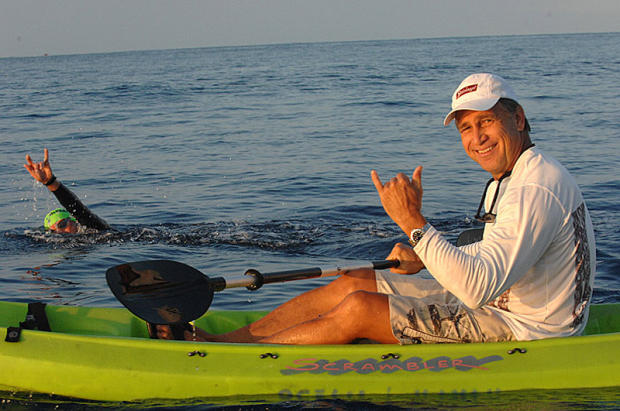Swimming Photo Gallery 2
Slowtwitch senior correspondent and photographer Timothy Carlson offers the second of three photo galleries devoted to swimming. This one features running starts, dive starts, penned in starts, open water starts, epic Ironman starts and some early swim action.
When the starting gun or horn goes off, a switch goes off in the brain. Magically, all the nervous anticipation, dread, fear and excitement is channeled into learned motion and muscle memory. For a sport that holds deep allure for individualists, the entry portal is participation in a massive runaway herd where everyone risks getting bumped, jostled, whacked in the head with elbows or legs, run over, pushed under water and just plain discombobulated in a watery riot. Somehow, sheer instinct that might have been inherited from genetic ancestors like the migrating geese, dolphins or lemmings takes over. Emerging from that pack unscathed and finding a clear path offers a huge dose of excitement and post-swim satisfaction. It’s what philosopher William James called “The moral equivalent of war.”
Then, when the initial sprint to get clear is over and the swimmers settle into the steady rhythms of open water swimming, the hundreds of hours of drills and workouts take over. The better trained swimmers look smooth and sinuous and powerful. The worst of us look like eggbeaters thrashing the water into reckless, useless spray. While most swims are short and the differences between a great and mediocre swim can be overcome, the gulf between the good and bad swim is significant. After all, a triathlon is an energy equation, and an awkward stroke is the natatorial equivalent of a gas guzzling SUV.
Age group swimmers take off at 2006 USAT Nationals in Smithville, Missouri.
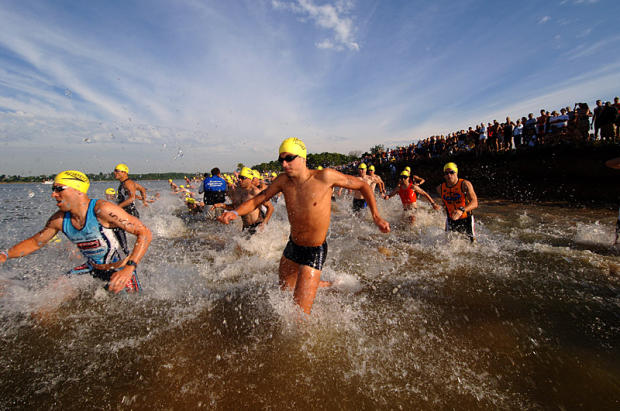
Brian Fleischmann dolphin dives out front while Lars Finanger enjoys the view in Boulder 5430 long course mens start.
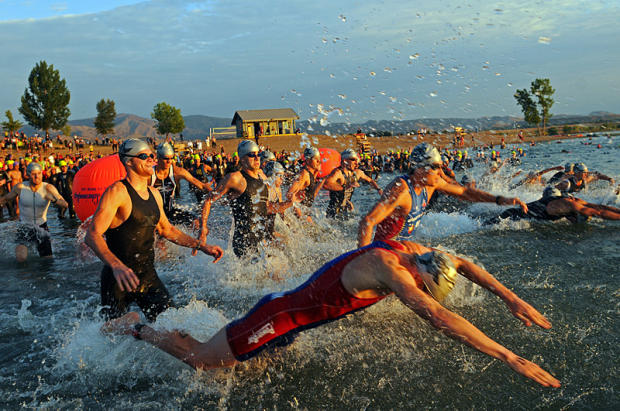
With hundreds of thousands of dollars at stake, the Life Time Fitness elite men charge at warp speed into the swim at Lake Nokomis.
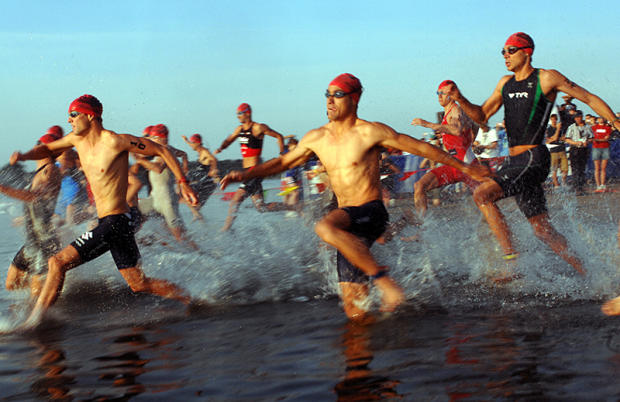
Age group women re-enact their own Charge of the Light Brigade at Boulder’s 5430 long course.
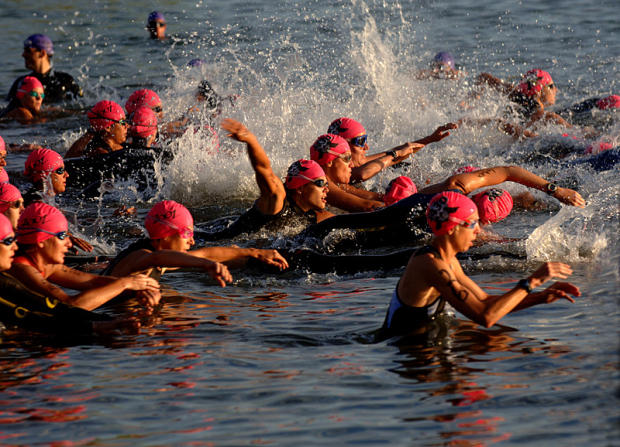
Frank Lee Morris and Clarence and John Anglin did not have modern wetsuits when they broke out of the Alcatraz prison in 1962 and disappeared. Without modern electronic tracking chips favored by triathletes, nobody knows if they live or died, much less their swim splits.
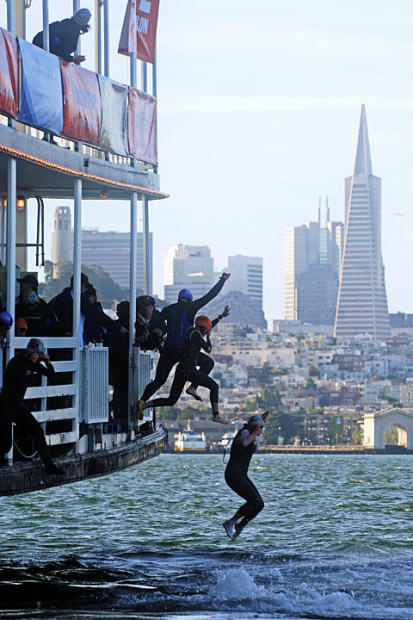
With Olympic slots on the line at the 2007 Beijing World Cup, the women’s field leaps off the start pontoon with fierce abandon. Stopped by the camera at one-thousandth of a second, the yearning fingers reaching for a clear slice at the waters of Shinsanling Reservoir constitute a shared prayer from an aerobic congregation.
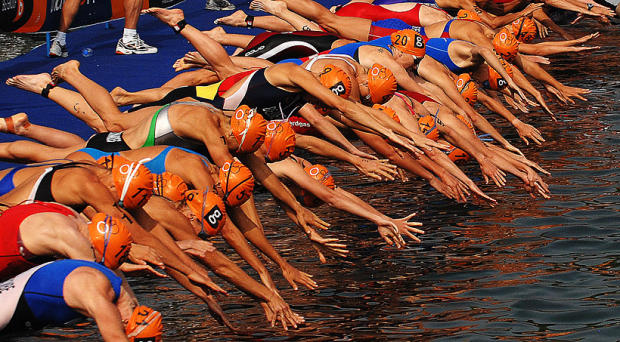
Seeking a world title at Hamburg in 2007, the elite men’s field leaps like cheetahs seeking the kill. The furthest of these leapers might challenge the best of the Splash Dogs leaping off docks.
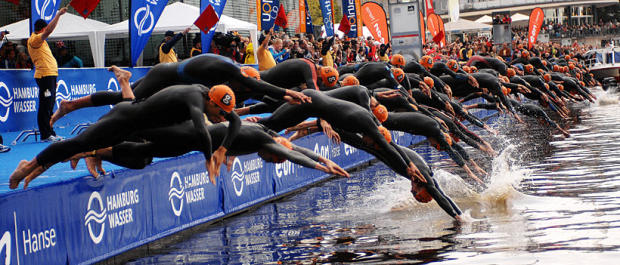
Pent up energy is released when this collegiate wave starts at Terry Davis’ Wildflower, and war-painted, balloon-antlered fans shout Go!
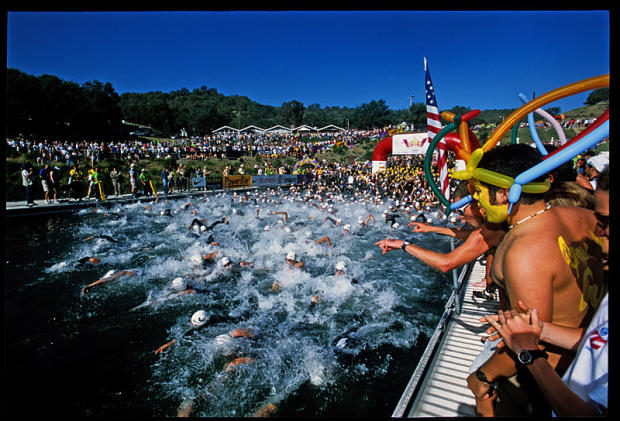
Some age group waves are packed in so tight at Wildflower’s boat ramp start, it looks like they explode out of a shotgun.
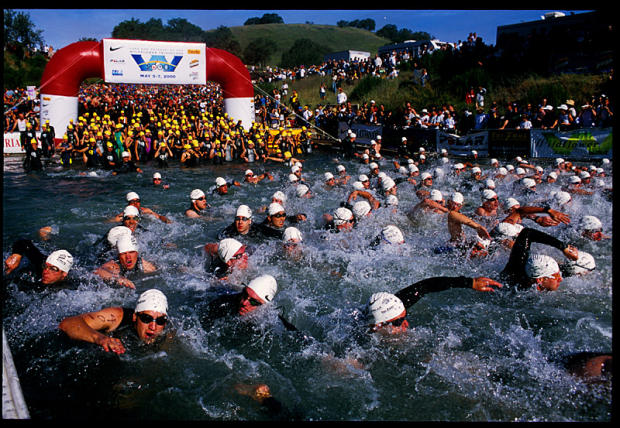
The waters of Shreveport’s Red River left swimmers cleaning out red mud from their ears and all available crevices for days afterward. But when the horn sounded, the response was pure crystal clear adrenaline.

Photographers mourned when Ironman Coeur d’Alene moved the swim start to the far side of the beach from an elevated mini-hill nearer the harbor. This epic mass start vantage point might have been chosen by director David Lean.
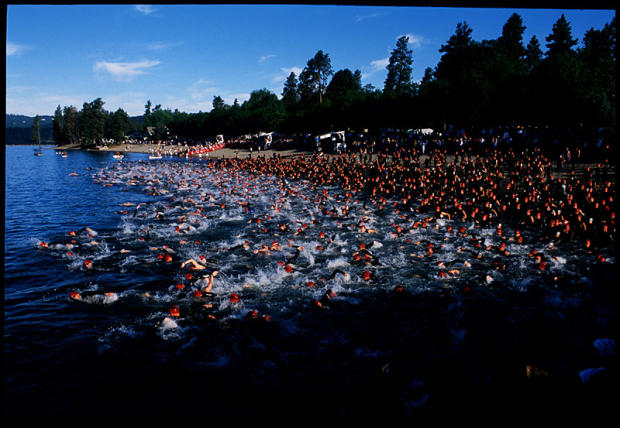
It began with 15 men rushing into the waters of Waikiki. Soon, it became a 1,500 man and woman cavalry charge in Kona that created a signature spectacle. No matter that untold amateurs and top pro women like Erin Baker and Sue Latshaw got punched in the head and/or knocked under the surface by crazed, testosterone-amped men. Ultimately, a sane compromise was reached – pros got a 15-minute head start.
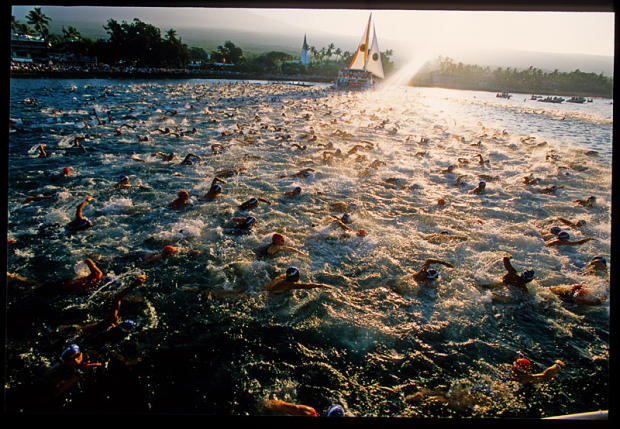
Ironman Switzerland in Zurich seems to be a bit more orderly than most mass starts.
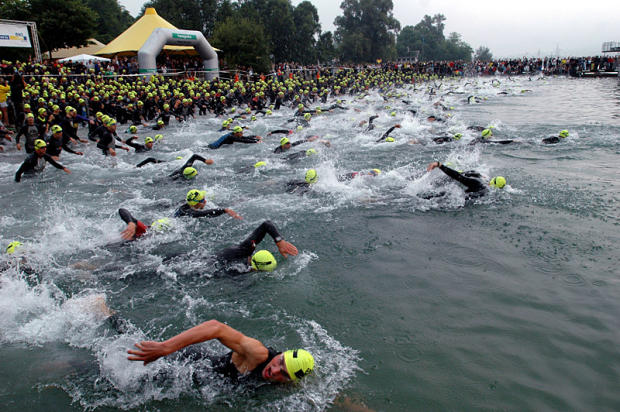
The Escape From Alcatraz swim offers an unparalleled urban panorama – if you breathe on the left side.
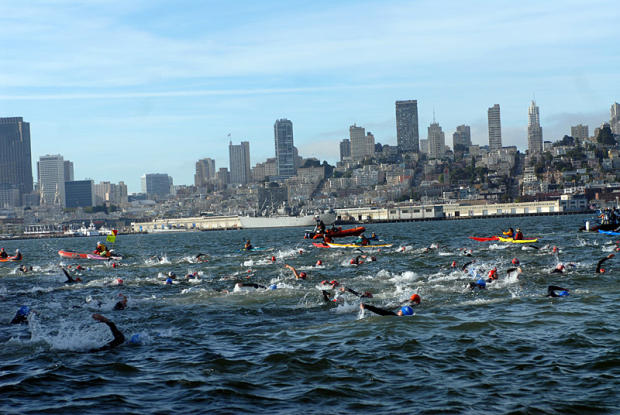
The Chicago Triathlon has been almost unique in providing spectators close access to the swim via a seawall adjacent to the buoys in Monroe Harbor.
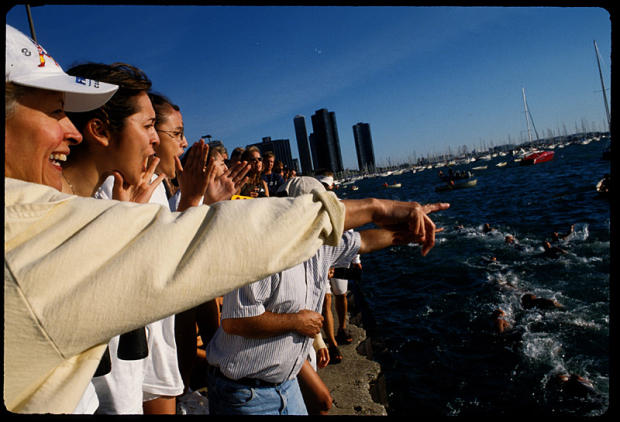
Wonder what a swim start is like in the highly competitive age group waves at a World Championship? Try Olympic water polo, score tied, final match.
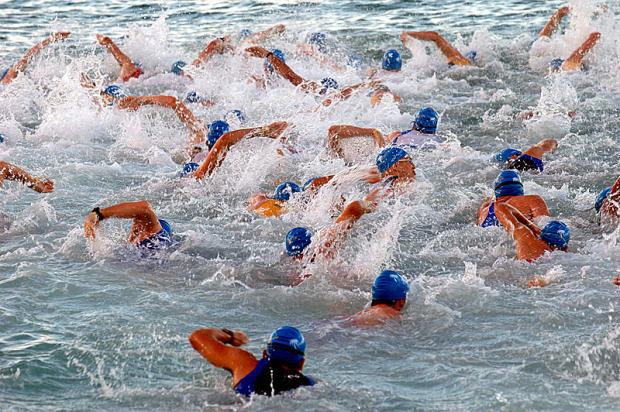
The Ironman Hawaii starting pack, jacked up on adrenaline, is a blind beast that must be re-routed inside the funnel on the correct side of the buoys.
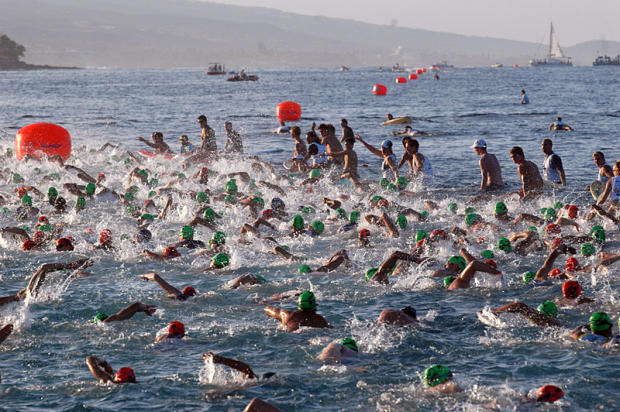
With a 35 entry maximum, the 10km Ultraman swim offers a more intimate look at competitors making their way toward Keauhou, the sun glinting off the goggles.
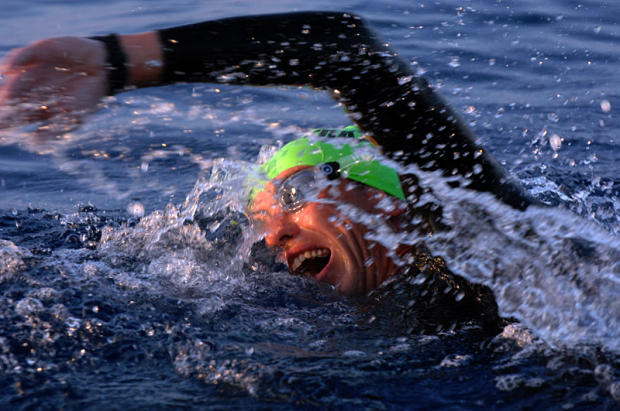
Sheila Taormina earned an Olympic gold medal on the 4×200 meter freestyle relay at the 1996 Olympics. In a triathlon career that included a 2004 ITU World Championship, Taormina often found herself waiting for the mere mortal swimmers to catch up. Here she makes do without goggles at the 2004 Honolulu US Olympic Trials.
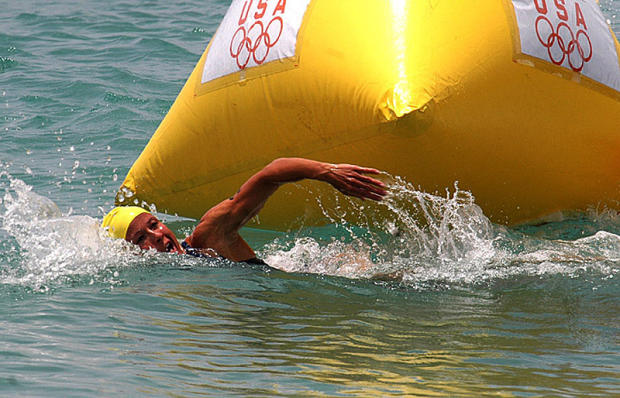
Ultraman offers swimmers the luxury of a personal kayak escort. Kayakers can provide water, gels and jellyfish medicine. But no tows.
